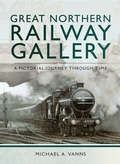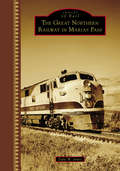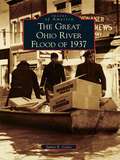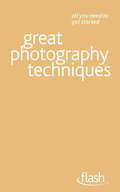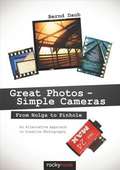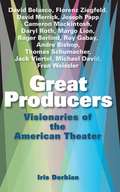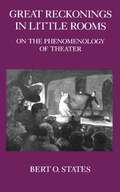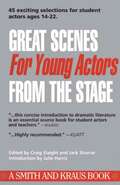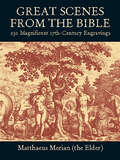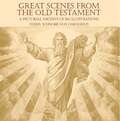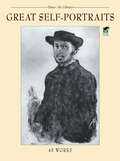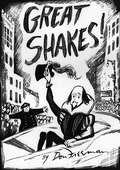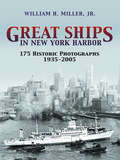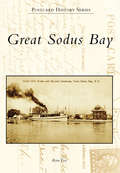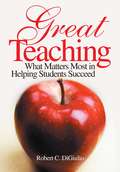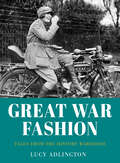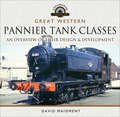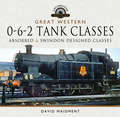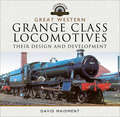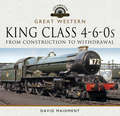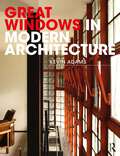- Table View
- List View
Great Northern Railway Gallery: A Pictorial Journey Through Time (Railway Gallery Ser.)
by Michael A. Vanns&“A simply fascinating and impressively informative illustrated history&” of the British steam railway by the author of The Leicester Gap (Midwest Book Review). The Great Northern Railway was one of 120 companies that ran trains in Britain during the Victorian and Edwardian period. Formed in 1846, it traded independently for seventy-six years until absorbed into the London & North Eastern Railway on 1 January 1923. Operating a network of nearly 700 route miles it ran trains between King&’s Cross, London and York, into the Eastern Counties and the East Midlands, the West Riding of Yorkshire, into Lancashire and even south of the Thames. It developed distinctive characteristics, both in the way it managed its affairs and in the appearance of its trains, stations, signals and signalboxes. Numerous photographs were taken, particularly from the 1890s onwards, by dedicated amateurs attracted to the lineside by the sight of speeding steam locomotives in apple green livery, hauling polished teak carriages. Goods trains and the endless procession of coal trains were not such popular photographic subjects, but by searching out these and images of staff, stations and signalboxes, this book aims to capture something of the spirit of a once-great organization in the heyday of Britain&’s steam railways. &“With the welcome increase in the pre-Grouping scene engendered by projects such as the Hatton&’s &‘Genesis&’ coaches, books such as this will find a new audience, which is no bad thing.&” —Railway Modeller &“Vanns certainly presents a splendid collection of period images displaying numerous aspects of the railway&’s operations.&” —Best of British
Great Northern Railway in Marias Pass, The (Images of Rail)
by Dale W. JonesMontana’s Marias Pass is the lowest rail crossing through the Rocky Mountains. The tracks snake through narrow canyons, traverse the swift Middle Fork of the Flathead River, and twist through numerous snowsheds and tunnels to crest the 5,213-foot Continental Divide. James Jerome Hill was the driving force behind Great Northern Railway’s mission to find the most economical route to the Pacific coast, with surveyor John F. Stevens taking a major role in locating the pass. Browning is the eastern gateway into Marias Pass as the railroad approaches the Rocky Mountain Front; continuing west from Summit, the tracks parallel Bear Creek and the Middle Fork of the Flathead River downgrade through Essex to Glacier National Park and into the Flathead Valley.
Great Ohio River Flood of 1937, The
by James E. CastoFrom the time settlers first pushed into the Ohio Valley, floods were an accepted fact of life. After each flood, people shoveled the mud from their doors and set about rebuilding their towns. In 1884, the Ohio River washed away 2,000 homes. In 1913, an even worse flood swept down the river. People labeled it the "granddaddy" of all floods. Little did they know there was worse yet to come. In 1937, raging floodwaters inundated thousands of houses, businesses, factories, and farms in a half dozen states, drove one million people from their homes, claimed nearly 400 lives, and recorded $500 million in damages. Adding to the misery was the fact that the disaster came during the depths of the Depression, when many families were already struggling. Images of America: The Great Ohio River Flood of 1937 brings together 200 vintage images that offer readers a look at one of the darkest chapters in the region's history.
Great Photography Techniques: Flash
by Lee FrostDo you want to be able to take brilliant photos but dont know where to begin? Get a kickstart with this little book which will give you just enough to get you going...
Great Photography Techniques: Flash
by Lee FrostDo you want to be able to take brilliant photos but dont know where to begin? Get a kickstart with this little book which will give you just enough to get you going...
Great Photos - Simple Cameras
by Bernd DaubWhen we look at everyday life, we realize that it is far from easy. Indeed, we are often confronted with the contrary: complicated instead of simple; demanding instead of effortless. As photographers, we face a similar situation with regard to our chosen hobby. The camera and computer are wonderful technical instruments, but their growing complexity can sometimes take away from the joy we find when we engage in creative work. In this book, author Bernd Daub shows us that simplicity works. He describes how with simple camera techniques, traditional film, and some imagination we can create ambitious artwork. This book teaches us how to focus our attention on the motivation behind our chosen image and develop a strong image impact without the need for high-tech equipment and flawless exposures. Learn about a variety of reasonably priced, low-tech cameras-such as the Holga, Diana, and Blackbird-as well as single-use cameras, the good old Agfa-Box, and the pinhole camera. For price-conscious beginners and intermediate photographers with high-quality equipment, this book provides ideas for alternative techniques without large investments. You'll discover many new possibilities as you foster your creativity.
Great Producers: Visionaries of American Theater
by Iris DorbianUp close and personal with Broadway's brightest lights of the past, present, and future. * Firsthand accounts, rare interviews, backstage anecdotes * Insider ideas from Disney, Jujamcyn, Mackintosh, Weissler, Papp, Merrick, Ziegfeld, more! Meet the movers and shakers who shape what we see on Broadway. In this insider's look at the producers behind the shows, Broadway's most esteemed visionaries tell all--how they got started in the business, how they chose projects, how they raise money, and more.
Great Reckonings in Little Rooms: On the Phenomenology of Theater
by Bert O. StatesThis is a book about the theater phenomenon. It is an extension of notes on the theater and theatergoing that have been accumulating for some time. It does not have an argument, or set out to prove a thesis, and it will not be one of those useful books one reads for the fruits of its research. Rather, it is a form of critical description that is phenomenological in the sense that it focuses on the activity of theater making itself out of its essential materials: speech, sound, movement, scenery, text, etc. Like most phenomenological description, it will succeed to the extent that it awakens the reader's memory of his own perceptual encounters with theater. If the book fails in this it will be about as interesting to read as an anthology of someone else's dreams. In any case, this book is less concerned with the scientific purity of my perspective and method than with retrieving something from the theater experience that seems to me worthy of our critical admiration.
Great Rides of Today's Wild West: A Horseman's Photographic Journey Across the American West
by Mark BedorVeteran travel writer, photographer, and horseman Mark Bedor returns with another breathtaking adventure across the American West. This gorgeous photographic collection showcases twenty-six horseback rides across the United States (with one trip abroad to the great Australian Outback). For each, Bedor offers firsthand descriptions of the people and places, whether they’re tagging along on a cattle drive, taking part in a re-creation of Custer’s Last Stand, or just soaking in the natural vistas. Take part in the Great American Horse Drive in Colorado; ride through the spectacular Sierra Nevada at Inyo National Park; and step back in time to the Old West at Tombstone Monument Ranch. Whether the locations are working dude ranches, historic national parks, or world-famous travel destinations, Great Rides of Today’s Wild West shows them in full splendor through more than three hundred spectacular photographs by the author. The beauty, romance, and history of the Wild West and magnificent natural landscapes attract people from all over the world. This book lets you saddle up and ride across the country and beyond on some of the finest trails of today’s Wild West.
Great Scenes For Young Actors From The Stage (Young Actors Ser.)
by Craig Slaight Jack SharrarGreat Scenes for Young Actors (Young Actors Series)
Great Scenes from the Bible: 230 Magnificent 17th-Century Engravings (Dover Pictorial Archive)
by Matthaeus MerianRemarkably detailed illustrations depict Adam and Eve Driven Out of the Garden of Eden, The Flood, David Slaying Goliath, Christ in the Manger, The Raising of Lazarus, The Crucifixion, and many other scenes. A wonderful pictorial dimension to age-old stories. All 230 plates from the classic 1625 edition.
Great Scenes from the Old Testament: A Pictorial Archive of 160 Illustrations (Dover Pictorial Archive)
by Julius Schnorr von CarolsfeldOne of the most inspired painters of the nineteenth century, Julius Schnorr von Carolsfeld (1794 -1872) was also a brilliant engraver and draftsman. This collection, among his major accomplishments, includes scores of engravings that bring to life familiar scenes from the Old Testament - from the creation of the world and the fall of Adam and Eve to the story of Noah and his Ark and David's slaying of Goliath. Imbued with a sense of grace and spontaneity, Schnorr von Carolsfeld's monumental compositions pay minute attention to detail. Each of the 160 beautifully composed images, selected from a rare nineteenth-century publication, is accompanied by a caption citing title and biblical book and chapter.An important reference for students and scholars of scriptural studies, this handsome archive will also serve as an important sourcebook for designers and commercial artists.
Great Self-Portraits
by Carol Belanger GraftonWhat does a self-portrait tell us about the artist? Readers are invited to find out in this unique addition to Dover's popular Art Library Series. Drawings in pen, ink, and charcoal, as well as etchings and engravings, encompass 45 splendid self-portraits. Subjects range from such 15th-century artists as Gentile Bellini, Leonardo da Vinci, and Albrecht Dürer to a host of 19th-century masters: James Whistler, Auguste Rodin, Vincent van Gogh, Berthe Morisot, Aubrey Beardsley, and many more. Among the other artists depicted here is the avid self-portraitist Rembrandt van Rijn, in one of his trademark hats, along with Peter Paul Rubens, Francisco de Goya, William Blake, and Camille Pissarro. Artists, art historians and art lovers will enjoy discovering the emotions, character traits, and nuances of personality revealed in these masterly self-portraits.
Great Shakes
by Don FreemanIn simple yet all-telling black-and-white graphics, Freeman unfolds a humorous, lively, deeply human, and yet modern story of William Shakespeare being brought down from Heaven to help Hollywood out of a creative depression. Naturally, in a new environment, "Shakes" cannot produce hit material on call... and so his adventures begin – with humorous and deep consequences, all told without words! Enjoy Don Freeman's humour and his wonderful and sense of life with all of humanity' highs and lows and in-betweens.
Great Ships in New York Harbor: 175 Historic Photographs, 1935-2005
by William H. MillerA vibrant profile of New York Harbor, this illustrated chronicle traces the great port's history from its heyday in the 1930s to the present. Its informative text, complemented by 175 vintage photographs, conveys fascinating details in a conversational tone, making it as interesting to read as it is to browse.Great Ships in New York Harbor captures the bustling excitement of the busiest marine terminals in the world. It ranges from the elegant sophistication of the ships in the uptown piers known as Luxury Liner Row to the commercial hubbub of the downtown docks and their freighters, tramp steamers, tugs, and barges.Maritime expert William H. Miller, Jr., ranks among the best guides to the Port of New York. The author of numerous books on ships, he has traveled aboard all manner of vessels, often in the capacity of guest lecturer or journalist. Miller's books feature personal recollections and anecdotes from passengers who sailed on historic ships, and his unique selection of new and different pictures offers fresh perspectives on even the most-well-known vessels.
Great Sodus Bay (Postcard History)
by Rosa FoxGreat Sodus Bay graces the southern shore of Lake Ontario. Known as Bay of the Cayugas to early French explorers and Assorodus (Silvery Waters) to Native American Indians, Sodus Bay is bountiful in beauty and history. Host to many creative souls, entrepreneurs, and seekers of nature, relaxation, and recreation, Great Sodus Bay has captured the hearts of all who visit. The images in this volume provide a tour of the communities and commercial developments, as well as historic lighthouses, vintage boats, and architecture. Take a nostalgic look at Great Sodus Bay from 1890 to 1930--an era of newfound popularity as Sodus Bay developed into a destination resort.
Great Teaching: What Matters Most in Helping Students Succeed (1-off Ser.)
by Robert C. DiGiulioAmid the 'high-stakes’ climate of public education today, DiGiulio’s book reminds us of far more important outcomes than politicized test scores. Plain and simple, the book resonates with common sense.
Great War Fashion: Tales from the History Wardrobe
by Lucy AdlingtonImagine stepping into someone else’s shoes. Walking back in time a century ago, which shoes would they be? A pair of silk sensations costing thousands of pounds designed by Yanturni of Paris, or wooden clogs with metal cleats that spark on the cobbles of a factory yard? Would your shoes be heavy with mud from trudging along duckboards between the tents of a front-line hospital or stuck with tufts of turf from a football pitch? Would you be cloaked in green and purple, brandishing a ‘Votes for Women’ banner, or would you be respectably dressed, restricted by your thigh-length corset? Great War Fashion opens the wardrobe of women in the years before the outbreak of war to explore the real woman behind the stiff, mono-bosomed ideal of Edwardian society, and closes it on a new breed of women who have donned trousers and overalls to feed the nation and work in munitions factories and who, clad in mourning, have loved and lost a whole generation of men. The journey through Great War Fashion is not just about the changing clothes and fashions of the war years – it is a journey into the lives of the women who lived under the shadow of war and were irrevocably changed by it. Using material from her own extensive collection, renowned costume expert Lucy Adlington brings an inspiring generation of women to life with rare and stunning images alongside a narrative that is both deeply poignant and laugh-out-loud funny.
Great Western Pannier Tank Classes: An Overview of Their Design & Development (Locomotive Portfolios)
by David MaidmentThis comprehensive and fully illustrated history presents an in-depth look at the Great Western Railway&’s various pannier tank engines. Though hauling freight was a vital part of Great Western Railway&’s history—and where it made the majority of its profit—there are few books devoted to the stout, powerful engines that did the work. In Great Western, Pannier Tank Classes, British Railways expert David Maidment corrects that oversight. This volume explores the large number of 0-6-0 saddle tanks built for both the Great Western Railway and the independent railway companies in South Wales, most of which were converted to pannier tanks in the Churchward and Collett eras. While covering the Armstrong and Dean engines in detail, Maidment goes on to describe the design, construction and operation of the largest class of steam engines built in the UK in the last century: Charles Collett&’s GWR 5700 class, examples of which were still being built after nationalization. Collett also designed pannier tank engines for branch passenger and freight work, and his successor Frederick Hawksworth continued the GW tradition with a tapered boiler version. All of these are discussed in depth in terms of their design and service. A concluding chapter covers further designs that were never built.
Great Western Pannier Tank Classes: An Overview of Their Design & Development (Locomotive Portfolios)
by David MaidmentThis comprehensive and fully illustrated history presents an in-depth look at the Great Western Railway&’s various pannier tank engines. Though hauling freight was a vital part of Great Western Railway&’s history—and where it made the majority of its profit—there are few books devoted to the stout, powerful engines that did the work. In Great Western, Pannier Tank Classes, British Railways expert David Maidment corrects that oversight. This volume explores the large number of 0-6-0 saddle tanks built for both the Great Western Railway and the independent railway companies in South Wales, most of which were converted to pannier tanks in the Churchward and Collett eras. While covering the Armstrong and Dean engines in detail, Maidment goes on to describe the design, construction and operation of the largest class of steam engines built in the UK in the last century: Charles Collett&’s GWR 5700 class, examples of which were still being built after nationalization. Collett also designed pannier tank engines for branch passenger and freight work, and his successor Frederick Hawksworth continued the GW tradition with a tapered boiler version. All of these are discussed in depth in terms of their design and service. A concluding chapter covers further designs that were never built.
Great Western, 0-6-2 Tank Classes: Absorbed & Swindon Designed Classes (Locomotive Portfolios)
by David MaidmentDescriptions and hundreds of photos of these tank engines that played a major role in Welsh coal mining and passenger rail.After tackling the Great Western Railway’s pannier tanks in a previous Locomotive Portfolios volume, David Maidment seeks out descriptions and photographs of the GW 0-6-2 tank engines, the majority of which were built by the Rhymney, Taff Vale, Barry, and other Welsh railways from the last decade or so of the nineteenth century onward. The engines of eight different companies, absorbed by the GWR in 1922, are described and illustrated, as well as the way in which many were modernized and rebuilt at Swindon or Caerphilly Works in the 1920s. GWR Chief Mechanical Engineer Charles Collett was, however, faced with a motive power crisis in the mining valleys at the Grouping, as many of the companies had economized on essential maintenance as the GW’s takeover drew near, and he had to hurriedly design a standard 0-6-2T to complement and bolster their work as the powerful GW 2-8-0Ts were too heavy and wide for many of the Cardiff valleys. These engines, the 56XX & 66XX classes, became part of the South Wales scene between 1925 and 1964, mainly running the coal traffic between pits and docks, although they dominated Cardiff Valley passenger services until the influx of BR 3MT 2-6-2Ts and GW 41XX 2-6-2Ts in 1954 and 1955. With around 300 black & white photographs, this book takes a wide-ranging look at these locomotives.
Great Western, 0-6-2 Tank Classes: Absorbed & Swindon Designed Classes (Locomotive Portfolios)
by David MaidmentDescriptions and hundreds of photos of these tank engines that played a major role in Welsh coal mining and passenger rail.After tackling the Great Western Railway’s pannier tanks in a previous Locomotive Portfolios volume, David Maidment seeks out descriptions and photographs of the GW 0-6-2 tank engines, the majority of which were built by the Rhymney, Taff Vale, Barry, and other Welsh railways from the last decade or so of the nineteenth century onward. The engines of eight different companies, absorbed by the GWR in 1922, are described and illustrated, as well as the way in which many were modernized and rebuilt at Swindon or Caerphilly Works in the 1920s. GWR Chief Mechanical Engineer Charles Collett was, however, faced with a motive power crisis in the mining valleys at the Grouping, as many of the companies had economized on essential maintenance as the GW’s takeover drew near, and he had to hurriedly design a standard 0-6-2T to complement and bolster their work as the powerful GW 2-8-0Ts were too heavy and wide for many of the Cardiff valleys. These engines, the 56XX & 66XX classes, became part of the South Wales scene between 1925 and 1964, mainly running the coal traffic between pits and docks, although they dominated Cardiff Valley passenger services until the influx of BR 3MT 2-6-2Ts and GW 41XX 2-6-2Ts in 1954 and 1955. With around 300 black & white photographs, this book takes a wide-ranging look at these locomotives.
Great Western, Grange Class Locomotives: Their Design and Development (Locomotive Portfolios)
by David MaidmentThe renowned British railroad historian delivers &“a well-illustrated account of the rationale behind Collett&’s construction of this 80 strong class&” (West Somerset Railway Association). English railway engineer George Jackson Churchward proposed a 5ft 8in wheeled 4-6-0 for mixed traffic duties in 1901 and it was seriously considered in 1905, but it took until 1936 before his successor, Charles Collett, realized the plan by persuading the GWR Board to replace many of the 43XX moguls with modern standard mixed traffic engines that bore a remarkable likeness to the Churchward proposal. David Maidment has written another in his series of &“Locomotive Portfolios&” for Pen & Sword to coincide with the construction of a new &“Grange&” at Llangollen from GW standard parts to fill the gap left by the total withdrawal and scrapping of one of that railway&’s most popular classes—to their crews at the very least. As well as covering the type&’s design and construction, the author deals comprehensively with the allocation and operation of the eighty locomotives and in particular has researched their performance and illustrated it with many examples of recorded logs from the 1930s as well as in more recent times. As in previous volumes, the author has added his own personal experiences with the engines and has sourced more than 250 photos, over 40 of which are in color. &“Superbly researched . . . another extraordinary and unreservedly recommended addition to . . . British Railroading History collections.&” —Midwest Book Review &“Granges worked off-region quite widely, so this is not just a book for the copper-capped chimney brigade; enthusiasts for whom these capable machines are favorites will definitely want this volume on the bookshelf.&” —Railway Modeller
Great Western, King Class 4-6-0s: From Construction to Withdrawal (Locomotive Portfolios)
by David MaidmentAn in-depth look at the British railway company’s celebrated class of steam locomotives, with more than three hundred photos.Built by Collett in 1927 after pressure to restore the Great Western Railway’s pre-eminence in motive power and cope with increasing postwar traffic to Devon and Cornwall holiday resorts, the thirty Kings were the final development of the Churchward Stars and the 1923 Castles and remained on top-link main line duty until their final replacement by the ‘Western’ class 52 diesel hydraulics in 1962. This book includes an insight into the thinking of some of Collett’s senior staff at the end of the 1930s and the eventual transformation in the latter years with redraughting and double chimneys. As well as describing their design and construction, the book comprehensively covers their operation and performance, backed up by many recorded logs on all main GW/WR routes over which they were permitted. The author had close experience of the class when working at Old Oak Common between 1957 and 1962, and includes a chapter of his experiences with them, including many footplate trips (as a management trainee, he was greeted with glee by firemen who would hand him the shovel). The book also includes over 300 photographs, one hundred of them in color.
Great Windows in Modern Architecture
by Kevin AdamsWindows are moments in modern architecture where we look to ascertain elegance, technical expression and material language or to capture a certain atmosphere. A window opening is as much an interval and an opportunity as it is a device for admitting light, air or views; it is simultaneously a physical aperture but also a philosophical opening of collaboration and reflection. In order to understand the language of a building we might look to the detail of the window. But what does this mean and why does modern architecture invest so much expression in the window?This book explores how the act of detailing and situating windows in buildings is a key proponent in the language of architecture, which both informs and works with the contingencies of design and construction. It investigates 18 case studies in-depth using painstakingly drawn details and vivid photographs in full colour to define what makes these windows “great” and how each window is situated within both its technical and philosophical context and as an overall development of modern architecture.Case studies include the work of Walter Gropius, Mies van der Rohe, Pierre Chareau, Frank Lloyd Wright, Alvar Aalto, Carlo Scarpa, Le Corbusier, Stirling and Gowan, Raili and Reima Pietilä, Louis Kahn, Peter Womersley, Miralles/Pinós, Steven Holl, Glen Murcutt and O’Donnell + Tuomey.
